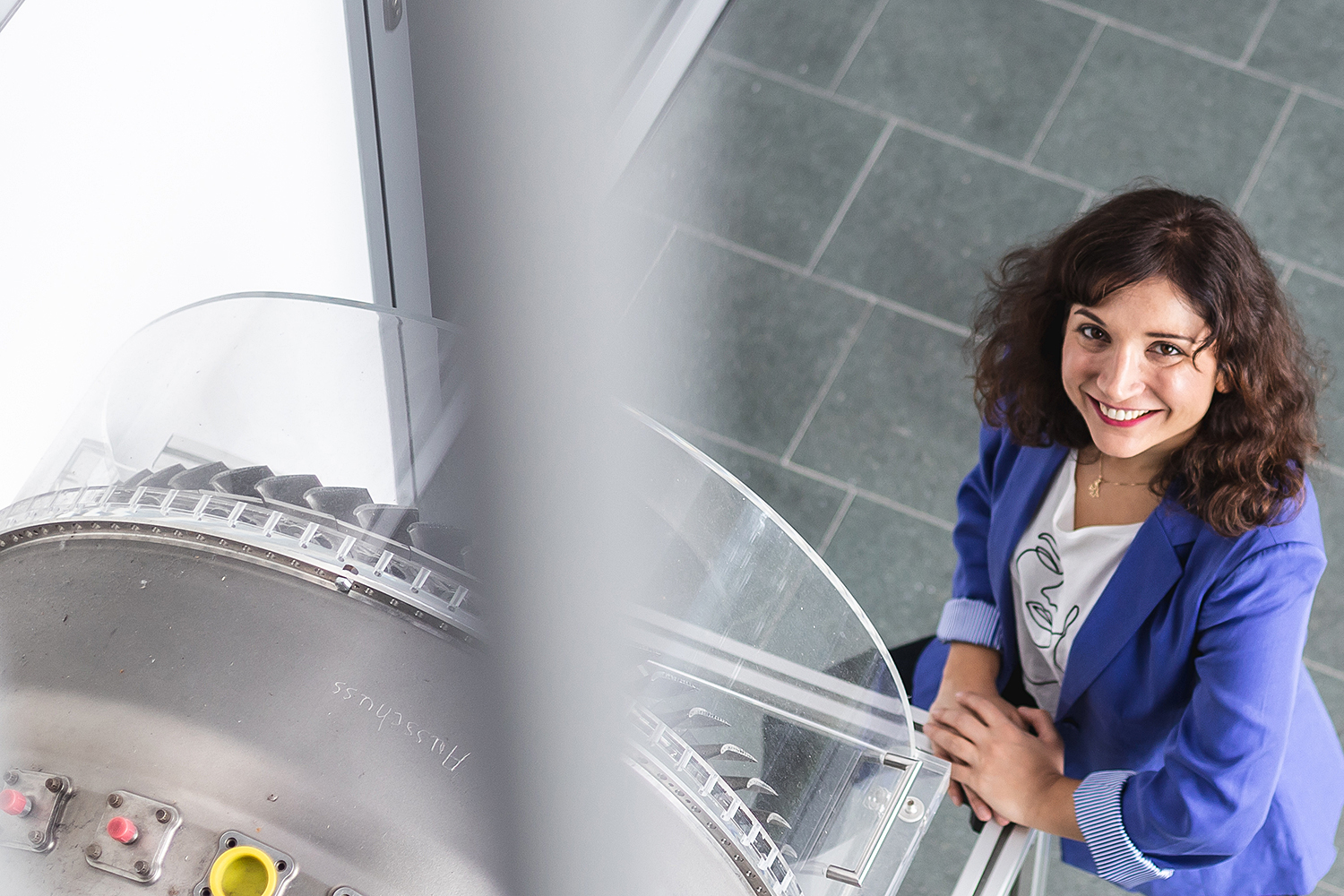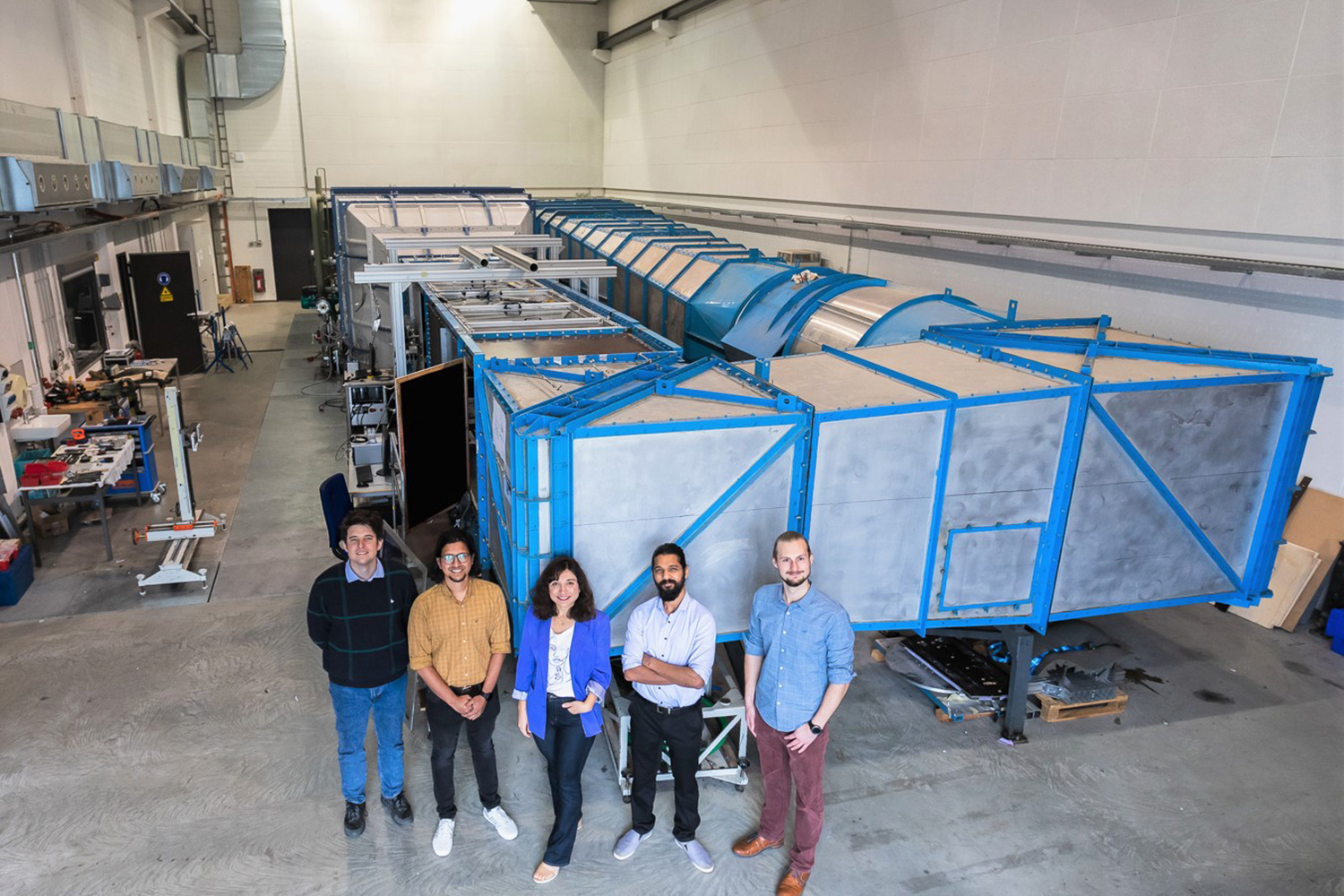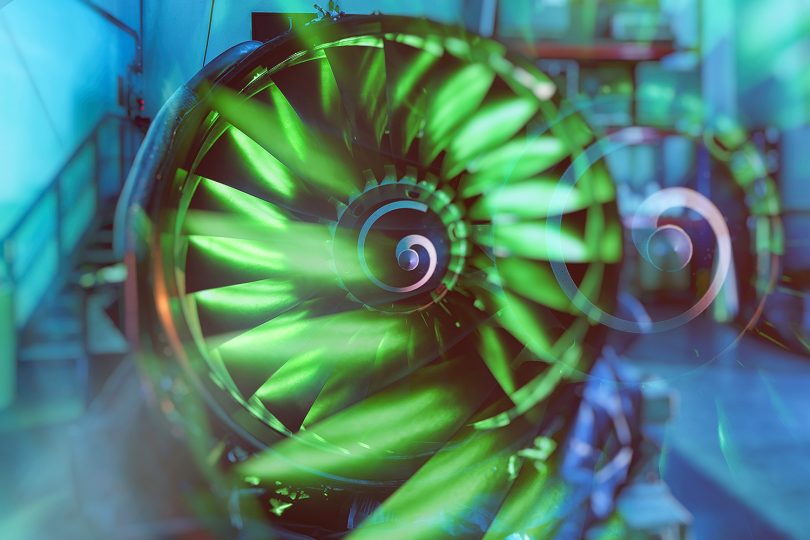Future Aviation: Research on Advanced Aircraft Designs for Green Aviation Interview with SE2A Junior Research Group leader Dr. Camli Badrya
Dr. Camli Badrya has been the junior research group leader of the “Flow Physics of Laminar Wing and Fuselage” at the Institute of Fluid Mechanics at TU Braunschweig since June 2019. As part of the Cluster of Excellence SE2A, she conducts research on optimizing flow physics on airfoils to find solutions for lower fuel consumption. We asked her how she came to Braunschweig at the TU and what exactly the topic of her research is.

Dr. Camli Badrya at the PTF Wind Tunnel facility,Institut für Flugantriebe und Strömungsmaschinen. Credits: Max Fuhrmann/TU Braunschweig
How did you get into science?
Since I can remember, I have always had a passion for science. Pioneers in the field of aviation such as Amelia Earhart, and the Wright brothers, as well as the great mathematicians Euler, Navier and Stokes, who’s work would be the foundation of my research, ignited my dream to someday become scientist and make my mark on aviation technology. This passion led me to earn my B.Sc. in Aerospace Engineering from the Israel Institute of Technology (Technion), a M.Sc., and finally a Ph.D. in Aerospace Engineering from the University of Maryland (UMD), United States.
With the completion of my Ph.D., it became clear that I wanted to remain in Academia for the foreseeable future. During the course of my studies at UMD, I have gained a well-versed background in numerical methods and helicopter aerodynamics design. My research work focused on unsteady viscous flow, bio-inspired flapping-wings, and large gust responses. After my post-doctoral period, I began looking for new research opportunities to expand my knowledge and to make an impact in Aerodynamics and Aviation.
Why did you choose the TU Braunschweig for your next academic job or position?
In late 2018, I came across the position of junior research group leader of “Physics of Laminar Flow Wings and Fuselage” at the Institute of Fluid Mechanics, TU Braunschweig. I was very thrilled to apply and get accepted to this position. The position at TU Braunschweig is within the Sustainable and Energy-Efficient Aviation SE2A, Cluster of Excellence in Germany.
I believe the many cultures I experienced during my education helped to give me more perspectives on difficult problems, and I was excited to continue my research in the country that fostered so many great scientists. The Institute of Fluid Mechanics (ISM) at TU Braunschweig has an impressive history in terms of research. It was founded and headed by the well-known fluid-dynamics scientist Prof. Hermann Schlichting (1907-1982). Schlichting studied under Ludwig Prandtl (1875-1953) who was a physicist, aerospace scientist and known for his pioneering work in Fluid-Dynamics. So, to be affiliated with TU Braunschweig is a great honor.
What are your main research areas at the TU Braunschweig?
My research group titled “Flow Physics of Laminar Wing and Fuselage”, is a junior research group within the Cluster of Excellence, SE2A. Our main research objectives focus on laminar flow control particularly by means of boundary layer suction.
Could you explain what “laminar flow control” is?
When a viscous fluid (i.e., air) encounters a solid surface, a boundary layer forms in response to the viscosity of the fluid and stationary surface velocity (no-slip boundary condition). Due to the viscosity in the boundary layer, we obtain “friction drag” or “skin friction drag”. Although this boundary layer is thin on wings, the friction drag can become quite significant on larger airplanes.
These boundary layers can be laminar, flowing smoothly over the surface, or turbulent, full of swirls and vortices. Laminar flow creates less friction drag, allowing for more efficient flight, however it is inherently unstable and can trip into turbulent flow due to unsteady conditions or imperfections in the surface. By active and passive means, we can extend and maintain laminar flow on the lifting surfaces. There are three approaches for laminar flow control on a wing:
- Passive Means: Mainly by airfoil shaping to obtain laminar flow. This may also refer to as Natural laminar flow (NLF). Because the natural laminar flow is sensitive to many parameters, this means that it is not as reliable.
- Active Means: Also known as laminar flow control (LFC). It was shown by Prandtl in 1935 that the laminar boundary layer can be controlled by suction. By removing the a small amount of air from the boundary layer before it becomes turbulent, laminar flow can be maintained more readily.
- Hybrid Means: Combining LFC and NLF approaches, hybrid laminar flow control (HLFC) uses advanced airfoil designs in conjunction with boundary layer suction to maintain a stable, laminar boundary layer in real world conditions.
The research conducted in my group is both numerical and experimental, and aims to investigate the physical principles and the impact of boundary layer suction on the laminar-to-turbulent, design and optimize the wing and fuselage for low drag, design a suction-based system for LFC/HLFC application, in synergy with novel 3d-printing and micro-perforated technologies.
Of course, this rich research could only be made possible because of the involvement of the excellent research group that consists of highly motivated master’s students and doctoral researchers from within and outside of Germany.

Dr. Camli Badrya (m.) and her team: Michelangelo Correlli Grappadelli (doctoral researcher), Adarsh Prasannakumar (doctoral researcher), Anand Sudhi (doctoral researcher), Fabian Zwilling (Master student). Credits: Max Fuhrmann/TU Braunschweig
While working in the Cluster of Excellence SE2A, what contribution do you see your research will make in terms of sustainable aviation?
The research we do in my group and other research groups within the Cluster of Excellence SE2A could lead to a breakthrough in the future of eco-friendly and energy-sustainable aviation. As explained above, the idea of laminar flow control by boundary layer suction is not novel. However, building a wing with active suction is not a trivial task. We are working to produce design tools which are able to capture the physics behind HLFC and to develop the keystone technologies to actually produce the designs these tools help create.
With better experimental data combined with improved computational capabilities, we can observe, understand, and predict the optimal physics. This knowledge will allow us to design airplanes with the HLFC application. Airplanes with the extended laminar flow will lead to significant drag reduction comparing with state-of-the-art transport airplanes. Less drag means less fuel to burn, and less emission of CO2 and other gasses.
What was your best experience as a scientist?
I have been engaged in academic life now for almost ten years after completing my bachelor’s degree. I can think of two experiences that I had as a researcher that have impacted me greatly.
My first milestone experience was when I passed my comprehensive verbal exam at the end of my Ph.D. in front of a committee of five professors in my field. When they brought me back into the exam room to tell me I had passed, I was no longer one of their students, but instead one of their colleagues.
The second experience was when I was awarded Amelia Earhart Fellowship Award and received the symbolic wings that are part of the award. Amelia Earhart, who was a pioneer female pilot, was and still is one of my heroes.
An outlook on the future: What are your plans?
In the coming years, I plan to continue working on my research towards designing and developing better aviation. As well as deepen my expertise and knowledge in applied aerodynamics and flow control, particularly with the work on transonic airplanes. In my opinion, we have much more ground to cover in terms of fundamental research that required advanced experimental and numerical methods. I also must expand my research field towards high-speed supersonic flows applications and solving complex flow physics.
In terms of academic career, to continue mentoring and educating young aerospace engineers to make an impact by using science and engineering to find solutions for the challenges that we are currently dealing with in our ever-changing world.
What message would you like to give to students?
I want to give them three messages: Be Curious! Curiosity and thinking outside of the box are essential qualities to be a good researcher or Scientist. Be Resilient! The research life is not an easy path to take. Be mindful that in research there is no “failure”. All great inventions in science were not invented on the first try. Learn from your setbacks and push forward. Be Fearless! Do not be afraid to bring “yourself”, make your mark to impact the discourse and culture in academia and industry.

